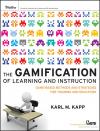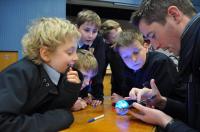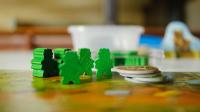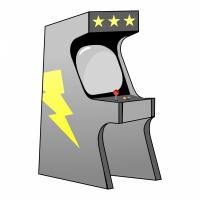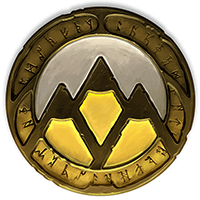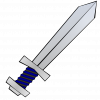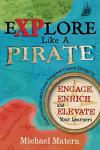Gamification
Game-based learning, gamification, and game development – what's the difference?
Game-based learning and gamification are both trying to solve a problem, motivate, and promote learning using game-based thinking and techniques.
- Gamification involves turning the learning process, as a whole, into a game by applying game principles (e.g. point scoring, achievement badges, rules of play) to it in order to motivate and engage learners. Failure is a source of feedback and learning, collaboration is necessary, and learning and assessment are tightly integrated.
- Game-based learning (GBL) involves using a game as part of the learning process. GBL is aimed at teaching a discrete skill or specific learning outcome, rather than being a complete pedagogical system. It is an effective way to teach new concepts.
Game development is the process of designing and creating a digital game. Go to the Game development page for more information.
Rachel Bolstad (Senior researcher NZCER) talks about her research into the environment that games and simulations present for thinking differently about learning, and about what students and teachers might be doing. She suggests one of the best ways teachers can pick up ideas and explore their own use of games in the classroom, is by connecting with others and sharing.
The development of entertainment and commercial games with really engaging and immersive environments provides a huge opportunity for exploration, problem solving and creativity.
What’s going on in these game environments? What is it that keeps people in them and motivated and engaged and exploring?
“Enjoyment is the reason for players to begin, sustain, and repeat exposure to digital games.”
- The experience of "effectance" or the immediacy of feedback to the player.
- Repeated cycles of suspense and relief, curiosity, and an increase in self-esteem.
- The fascination of becoming part of an alternative reality and playing a new role in simulations of spatial environments and/or interesting narratives.
Key resource
Games, gamification, and game design for learning
This report discusses the potential of games to support learning in NZ schools.
Rachel Bolstad (NZCER) and Dan Milward (CEO Gamelab) talk about using games to deepen and enrich thinking – both through playing and through creating them.
Gamification in education
"Gamification is using game-based mechanics, aesthetics and game thinking to engage people, motivate action, promote learning, and solve problems."
Gamification is about applying game mechanics to learning content in order to create meaningful educational experiences.
Some elements of games that may be used to motivate learners and facilitate learning include:
- progress mechanics (points/badges/leaderboards, or PBL's)
- narrative and characters
- player control
- immediate feedback
- opportunities for collaborative problem solving
- scaffolded learning with increasing challenges
- opportunities for mastery, and leveling up
- social connection
- fun
- challenges
- music
Gamification is not...
-
Playing digital/video games that have been designed to teach content or skills
"Edutainment" games like Carmen Sandiego and SimCity may incidentally teach something about world geography and economics, but this isn't gamification.
-
Using existing non-educational games for textual analysis, or tools for study and learning
This is a different learning approach called game-based learning.
-
Using points and badges to reward the completion of ordinary tasks
When badges and reward points are not part of a purpose-built game-system, it won't take long for these rewards to lose value in the eyes of students. Gamification techniques should drive interactivity, problem-solving, skill-progression, and storytelling.
-
Making/designing video games
For more information on game-design in educational contexts, see Virtual reality supporting student learning .
More information »
- Games vs games-based learning vs gamification – Infographic explaining the differences between games, game-based learning, and gamification.
Motivating learners through gamified learning design
"Gamification is applying the most motivational techniques of games to non-game settings, like classrooms"
Gamified design can promote greater engagement and create an environment of intense focus that stimulates learning and retention of information. A successful gamified programme uses “four freedoms of play”:
- Freedom to fail – games allow mistakes to be made with little consequence.
- Freedom to experiment – games allow players to explore and discover new strategies and pieces of information.
- Freedom to assume different identities – games encourage players to see problems from a different perspective.
- Freedom of effort – games allow players to go through periods of intense activity and relative inactivity, so that players can pause and reflect on tasks they have accomplished.
Extrinsic motivators
Video games offer extrinsic rewards in the form of high scores and leaderboards, which give status and bragging rights to players.
Intrinsic motivators
Video games tap into intrinsic motivators by establishing clear goals and scaffolding learning by throwing incremental challenges at players as they progress. Skills learned in level 1 will be applied and tested in level 2 and so on.
- Stimulated curiosity: The learning is presented as inquiry – a question or problem that learners are interested in exploring and solving.
- Stimulated confidence: Learners feel they can achieve success within the learning by completing an internalised learning goal.
- Stimulated satisfaction: The learning is relevant – learners feel the learning was worth the effort, that it has wider applications towards their social and environmental context.
Self-determination theory
Self-determination theory (SDT) is an understanding of motivation that is used to explain activity and behaviour in both games and learning.
The key elements of SDT are:
- Autonomy – the feeling a person has when they are in control and can determine the outcome of their actions
- Competence – a need for challenge and a feeling of mastery
- Relatedness – connecting with others
When a learner feels autonomy, competence, and relatedness in their activity, they will be more likely to experience enjoyment and well-being.
Develop your gamified learning programme so that it encourages:
- making choices – offer learners multiple pathways towards achieving learning goals
- up-skilling – give learners opportunities to apply new skills and prove the acquisition of content-knowledge
- collaboration – find ways to encourage learners to work together to complete challenges and competitions.
More information »
- From gamification to gameful design and gameful experience in learning – An article explaining the motivating connections between games and learning.
Snapshot of learning
Gamified learning sparks engagement revolution
In this learning snapshot, leaders at St Thomas of Canterbury College lift engagement by embedding gamification and agency into learning.
Examples of gamification
Entering the Realm of the Nobles: Michael Matera
In this webinar, Michael Matera breaks down his approach to teaching medieval history through a "game of thrones" inspired, story-driven learning game.
5 Ways to Design Effective Rewards for Game-Based Learning
Vicki Davis walks teachers through her gamified primary school classroom in this Edutopia post.
GamifiED OOC
A YouTube channel with webinars from educators involved in gamification.
More information »
Gamification and the future of education – An overview of gamification with snapshots of gamified learning from the world government summit.
Designing a gamified learning programme
There is no set list of game mechanics that will work for every situation. There are key game elements that can help guide your thinking. This section:
- introduces some of the key thinking around using a gamified approach in learning design
- provides tips, strategies, and digital tools for designing gamified learning programmes.
"Allowing for content, choice, and challenge to merge in a way that puts the student in control is no easy task, and that is where an intentional gamified structure is essential."
A purposefully gamified learning programme:
-
facilitates a learning environment based on play
- inspires students to engage more deeply with learning
- adds new energy and dynamism to lessons and units
- develops student agency by offering greater choice in learning
- fosters a sense of control over learning as students see the effects of their choices while they advance through the game
- encourages collaboration and teamwork as students work together to "win the game"
- engages learners by tapping into intrinsic motivators like curiosity, imagination, confidence, challenge, and satisfaction
- helps learners track progress and appreciate milestones and achievements.
Gamification can be both small and large in scope. Start small by infusing game elements into a single lesson, or a particular aspect of the learning. Take it further by gamifying entire units.
Game goals and learning outcomes
Karl Kapp tells us that "the simple introduction of a goal adds purpose, focus, and measurable outcomes. You now have a method to measure the quality of play..."
Good games guide players through a process of mastery. The end level or "boss battle" is usually a chance for the player to apply everything they've learnt so far in a final, compelling challenge. A clear goal is fundamental to orientating learners within your gamified programme.
Focusing questions
- What are your learning goals within the curriculum?
- How can you combine the learning goals with the game goals e.g. gaining a high score, moving to the next level etc.?
- What skills and knowledge will your students need to achieve those goals?
- How can you develop a gamified programme that guides students towards mastering their learning goals?
Strategies and tips
Embed choice into your learning goals
Ensure that learners have the freedom and autonomy to pursue goals using different methods and pathways. Empower your students by giving them choices within the game.
Ensure that goals are challenging but attainable
To truly motivate your students, differentiate the learning goals. Ensure goals are challenging yet achievable. A gamified learning environment is the perfect opportunity for your students to experience failure without risk, to try again when things go wrong, and to keep persisting. Devise clues, hints, and reward structures to help students achieve success.
Make sure that the goals are measurable
How do students show that a learning goal is met? Think about whether goal achievement involves completing a task, demonstrating a skill, creating something, or performing well during a challenge.
More information »
- Gamify any lesson, class or curriculum – Heather Marrs gives an overview of her gamified elementary class on this ISTE.org blog post.
- A theory of gamification principles through goal-setting theory – this conference paper provides research from a literature review on how setting goals can be used as a starting point for gamifying learning.
Reward structures, leaderboards, and tracking gamification data
If badges, points, and leaderboards are your only tool for gamifying learning, they will eventually run out of value for students. They can have a demotivating effect by crowding out intrinsic motivators for learning.
Using reward structures in conjunction with other game elements (such as competition, power-ups, items, challenges, goals, and story) can bring your entire learning programme together. If used purposefully, they can make learning visible and help students track their progress.
Strategies and tips
- Determine a point system to reward successful completion of and performance in game goals and challenges. For example, completing tasks might result in – to borrow a term from the gaming world – earning experience points (XP)
- Make sure the system is balanced so that competition is maintained throughout the learning programme. Don't let anyone lose the game too early.
- Throw "life jackets" to students at the bottom of the pack in the form of extra opportunities to earn points.
Tracking gamification data
Use digital tools to make tracking multiple students as they progress throughout the game an easy process that is not time-consuming.
- Tracking gamification data using a spreadsheet – An instructional tutorial with tips and strategies for managing experience points and leaderboard tracking by Jody Waltman.
Digital tools for tracking gamification data
Google Sheets
Manage gamification data and share with students. Mariana Garcia shares her Google Sheet leaderboard templates
.
5 easy steps to gamifying in Moodle
Neela Bell shares how Moodle can be used to gamify your class and provides a free downloadable guide.
ClassDojo
A gamified classroom LMS with an emphasis on community. It has a gamified feedback system that rewards students for completed tasks and positive behaviour. Feedback can be shared with parents.
Key resource
ClassCraft
Classcraft is a fully gamified LMS. It gamifies learning by embedding game mechanics into the functions normally associated with LMSs. For example, quizzes are boss battles, and unit objectives can be placed onto an interactive quest-map. It encourages collaboration by grouping students into teams of healers, warriors, and mages. It has an integrated system for tracking student progress that offers a range of analytics, such as time taken to complete tasks. It is compatible with Google Classroom.
Adding depth to your reward structures: Power-ups and items
-
Students could earn experience points for the successful completion of tasks and performance in challenges and competitions.
- These experience points could be converted for special level-ups or items that might change the condition of the game in the player's favour.
- By rewarding hard work with power-ups and items, moving up the leaderboard takes on extra meaning. It could give students an edge over other teams and players!
Getting my game up!
Gamification practitioner, Chris Aviles walks us through how leaderboard points can be converted to special powers and items in his item shop. Check out his online item shop
for students.
Competition and mini-games
Genuine competition offers learners a meaningful challenge – a chance for students to demonstrate their learning. By defeating a worthy opponent, learners will feel a sense of achievement that can be attributed directly to their learning. Turn knowledge review quizzes into fun battles and games.
Leaderboards
Point tracking can establish a motivating sense of competition across your entire learning programme.
Groups and teams
Separate the class into teams or groups. Create activities that foster collaboration, but also allow individual efforts to contribute to the team's overall progress. Tie competition victories to the game's reward structure.
Mini battles
Set up mini competitions or battles (quizzes that pit team against team, or even class against teacher). These competitions require learners to show knowledge gained throughout a learning programme.
Digital tools for creating competitions based on learning content and outcomes
Kahoot!
Kahoot is a game-based classroom response system. Create quizzes, project questions on the screen, and students answer them on their phones. Give students the choice to work as a team or an individual.sugarcane
Create learning games and share them with students.JeopardyLabs
Free web tool for creating jeopardy-style games.Quizlet
A mobile and web-based application that allows teachers to create learning games.flippity
A series of web apps. Works with Google Sheets to create dynamic education games.
Challenges
Create challenges which foster leadership and collaboration. Challenge your students to work together to solve a problem or create something.
Focusing questions
- How could you tie successful completion of challenges to in-game progress and achievement?
- How can you create challenges that complement the theme/story of your gamified learning programme?
Digital tools for creative challenges
MincraftEdu
Challenge teams to build something in minecraft that connects to your learning content.
Scratch
Create a video game in Scratch based on curriculum content.
Tinkercad
Design a boardgame based on curriculum content. Use Tinkercad to design pieces for the 3D printer.
Tools for problem-solving challenges
Breakout EDU
A learning game that uses the mechanics of panic rooms to create exciting and immersive classroom experiences for students. You can order a physical breakout kit, which contains a box with a series of locks and game templates that enable you to turn your curriculum content into a puzzle-adventure. Or, you can design your own digital version using these design tutorials
. Deepen the adventure by adding time constraints and placing clues around the school.
Room escape makers
A free online virtual panic room design tool. Create riddles and puzzles that are tied to your learning objectives.
Tips and strategies for gamifying learning
52 Gamification mechanics and elements
Andrjez Marcjewski shares a comprehensive list of game elements and mechanics that could be incorporated into your course design.
15 Ways Gamification Can Be Applied to Education
Melissa Stocco expands on 15 of Andrjez Macjewski's gamification elements providing tips and strategies for using them in the classroom.
Gamified maths class example
Ms. Cheafsky and Miss Corbo's gamified maths class site.
Top 10 +1 instructional game design best practises
Karl Kapp shares ten essential guidelines to follow when gamifying learning.
Level up with gamification
Social studies teacher, Tom Driscoll shares his guide to gamification in this google doc.
Examples of gamification in the classroom
Gamifiers in New Zealand
Brad and Hamish from St Thomas of Canterbury College explain gamifying their year 7-9 junior curriculum in this interview with Rachel Bostadt from NZCER.
Quest to learn (Q2L)
A public secondary school in New York where teaching is modelled on game-design principals. Units are called missions, which are broken up through the semester by smaller "quests".
Sorry, no items found.
Resources and readings
Key resources
A guide to gamifying the classroom. Michael Matera shows how weaving learning content together with storytelling, quest, adventure, and competition can create immersive and compelling learning environments for students in his book.
Karl Kapp explores the connections between pedagogy and game-theory while offering practical design strategies for gamifying learning programmes in his book.
Research
Educators who believe: Understanding the enthusiasm of teachers who use digital technologies in the classroom
This 2015 study used qualitative methods to explore why some teachers embrace the use of digital game-play (DGP) in the classroom. A summary of the research is on the Digital Education Research Network (DERN) blogpost – Teachers and digital games in the classroom
.
Mindshift guide to digital games and learning
(pdf)
This publication explores the opportunities and challenges of game-based learning, including useful tips and tricks for using games in the classroom.
From gamification to gameful design and gameful experience in learning
This study goes deeper into the motivating connections between games and learning.
A theory of gamification principles through goal-setting theory
This study goes into depth regarding how setting goals can be used as a starting point for gamifying learning.
Why Games Work and the Science of Learning
This paper examines the use of games to introduce material, improve understanding, and increase retention.
Blog posts
Gamifiers in New Zealand
Rachel Bostadt from NZCER interviews Brad and Hamish from St Thomas of Canterbury college on gamifying their year 7-9 junior curriculum.
5 Ways to Design Effective Rewards for Game-Based Learning
Vicki Davis walks teachers through her gamified primary school classroom in this Edutopia post.
Gamify any lesson, class or curriculum
Heather Marrs gives us an overview of her gamified elementary class on this ISTE.org blog.
5 Ways to gamify your classroom
Five ways to gamify your classroom to boost engagement, collaboration and learning are outlined in this blog from the ISTE website.
5 easy steps to gamifying in Moodle
Neela Bell explains how Moodle can be used to gamify your class.
Getting my game up!
Gamification practitioner, Chris Aviles walks explains how leaderboard points can be converted to special powers and items in his item shop. View his online item shop
for students.
25 storyline ideas to gamify your course
Neela Bell provides a list of story starters to kick off your gamified unit of learning.
52 Gamification mechanics and elements
Andrjez Marcjewski shares a comprehensive list of game elements and mechanics that could be incorporated into your learning design.
15 Ways Gamification Can Be Applied to Education
Melissa Stocco expands on 15 of Andrjez Macjewski's gamification elements providing tips and strategies for using them in the classroom.
Top 10 +1 instructional game design best practises
Karl Kapp shares ten essential guidelines to follow when gamifying learning.
The psychology behind why gaming helps students learn
Mitch Weisburgh, Co-Founder and Director at Games 4 Ed, explains the science behind why gaming helps students learn in this blog post from November 2015.
Netsafe: Tips for online gaming
This article by Netsafe talks about how to keep your family safe when gaming online.
Examples of gamification
The making of Gallipoli in Minecraft
Students from Alfriston College re-created the landscape of 1915 Gallipoli in Minecraft®, block by block. Working with Auckland Museum staff and utilising our First World War collections, the students learned about the experiences of the New Zealand service people in the 1915 campaign.
Quest to learn (Q2L)
A public secondary school in New York where teaching is modelled on game-design principals. Units are called missions, which are broken up through the semester by smaller "quests".
Gamified maths class example
Ms. Cheafsky and Miss Corbo's gamified maths class site.
Level up with gamification
Social studies teacher, Tom Driscoll shares his guide to gamification in this Google doc.
Infographics and pamphlets
30 facts about gamification in e-learning
An infographic about gamification in education.
Gamification and the future of education
This publication from the World Government Summit gives a clear overview of gamification as well as providing snapshots of gamified learning.
Games VS games-based learning VS gamification
An infographic explaining the differences between gamification and other game-based approaches to learning.
Professional learning and development
Curriculum for the future
A set of three resources designed to stimulate open-ended conversations about learning and curriculum today and into the future. The resources can be used separately or together, and in any order.
- Part 1 is a workshop resource
- Part 2 is a live action role play game
- Part 3 is a digital game for iPad or tablet
Download the App
- iTunes – Curriculum for the future
Entering the realm of the nobles: Michael Matera
In this webinar, Michael Matera breaks down his approach to teaching medieval history through a "game of thrones" inspired, story-driven learning game.
GamifiED OOC
This YouTube channel hosts webinars from educators involved in gamification.
Tracking gamification data using a spreadsheet
An instructional tutorial giving tips and strategies for managing experience points and leaderboard tracking from Jody Waltman.
Scratch overview
A video created by Michelle Chung and Karen Brennan of the ScratchEd team at Harvard University demonstrating how the programming language in Scratch can be used to create interactive art, stories, simulations, and games.
Games + The Future of Education (NZCER)
Join this Google+ community to share ideas, resources and participate in discussions about gamification and game based learning
Digital tools for gamification
MinecraftEdu
MinecraftEdu provides products and services that make it easy for educators to use Minecraft in the classroom. They make a special version of Minecraft specifically for classroom use. It contains many additions to the original game that make it more useful and appropriate in a school setting.
Minecraft in education
Information about using Minecraft in the classroom.
Tracking and managing gamification data
Google Sheets
Spreadheet tool that can be shared with students and used to manage gamification data.
ClassDojo
A gamified classroom LMS with an emphasis on community. It has a gamified feedback system that rewards students for completed tasks and positive behaviour. Feedback can be shared with parents.
Mini-games and competitions
Kahoot!
Kahoot is a game-based classroom response system. Create quizzes, project questions on the screen, and students answer them on their phones.
sugarcane
Create learning games and share them with students.
JeopardyLabs
Free web tool for creating jeopardy-style games.
Quizlet
A mobile and web-based application that allows teachers to create learning games.
flippity
A series of web apps. Works with google sheets to create dynamic education games.
Digital tools for creative challenges
MincraftEdu
Challenge teams to build something in minecraft that connects to your learning content.
Scratch
Create a video game in Scratch based on curriculum content.
Tinkercad
Design a boardgame based on curriculum content. Use Tinkercad to design pieces for the 3D printer.
Tools for problem-solving and collaborative challenges
Breakout EDU
A learning game that uses the mechanics of panic rooms to create exciting and immersive classroom experiences for students. You can order a physical breakout kit, which contains a box with a series of locks and game templates that enable you to turn your curriculum content into a puzzle-adventure. Or, you can design your own digital version using these design tutorials
. Deepen the adventure by adding time constraints and placing clues around the school.
Room escape makers
A free online virtual panic room design tool. Create riddles and puzzles that are tied to your learning objectives.
GooseChase EDU
Teachers set up missions for students that include scavenger hunt clues. Students can solve the clues on their phones by submitting a video or picture, adding text information, or by being present in a specific location through GPS. Teachers can create and monitor teams, assign start/end times, and have teams retry clues in real time.
Minecraft has always had ways for kids to team up, but this tool adds teacher controls to make it even easier to get students working together in the classroom. Whether it’s an entire class, small groups or pairs, students can collaborate on building projects that solve complex problems. Use the chat feature to provide feedback, and have the students use the camera tool to document progress. They can then go back after they’re done to see where they struggled and determine how to work better together next time.
Games
MIT Game Lab
The games available on this page were all created by students of the MIT Game Lab and for research purposes. These games are short, 5-15 minute experiences, each made as a polished vertical slice of gameplay.
Classcraft
Created by a physics teacher, Classcraft is a role-playing game for the classroom. Teachers are the Gamemasters, controlling the action. Students play in teams and pick from three unique classes (warrior, mage, healer), each of which come with their own health, ability points, and powers.
Mission US 2: "Flight to Freedom" Trailer
It’s 1848. You are Lucy King, a 14-year-old slave in Kentucky. You want to escape but how will you do it? Will you find a path to freedom? This one of four great games at Mission US, a multimedia project that aims to teach history content through interactive games.
GARBAGE DREAMS Theatrical Trailer
Take on the role of the Zaballeen, who recycle 80 per cent of the rubbish they collect on the streets of Cairo. Start with one neighbourhood, one factory, and one hungry goat. You have eight months to get recycling as high as you can. The game was developed to accompany the Garbage Dreams documentary
.
The last symphony – game design research
This is a hidden object game set in mid-1960s England. The player is a museum curator tasked with the creation of an exhibit about R. Carmine, a composer from your city with an unusual past. By finding the objects, players reveals the stories of the people who owned them and the melodies that go with them. It’s one of many games created by the MIT Game Lab
.
Typoman: a platform game where one letter changes everything
A clever hybrid of both platform games and puzzle games, Typoman asks you to overcome obstacles by manipulating words, in a black and white world of shifting ledges and shifting meanings. Do you need to find a way past a pool of water being filled by the word RAIN? Just swing the letter D towards it and watch the water DRAIN away.



